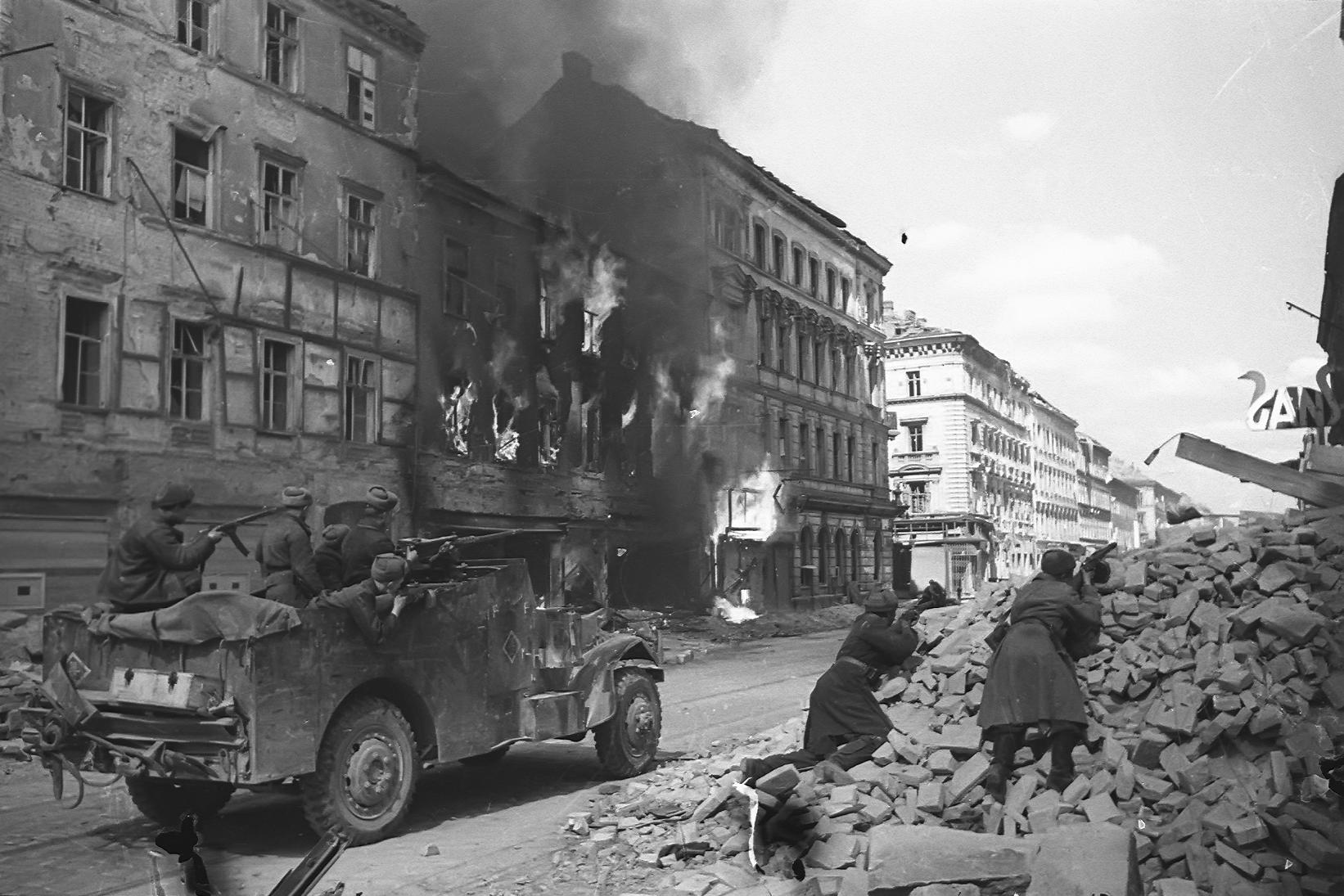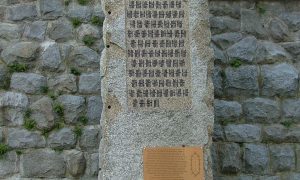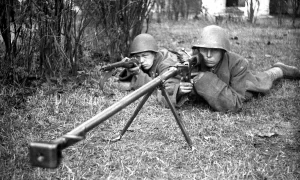Battle of Budapest WWII (1944)
The Budapest operation or Siege of Budapest was a strategic offensive operation by the Soviet forces during the Second World War in 1944-1945. It was carried out by the forces of the 2nd and 3rd Ukrainian fronts from the period of October 29, 1944 to February 13, 1945 with the aim of defeating German troops in Hungary and knocking out hungary from WW2. In addition, the offensive involved blocking enemy troops in the Balkans.
German troops were garrisoned on their allies territory of Hungary from March 1944 as part of (Operation “Margarete”). In September 1944, Soviet troops crossed the Hungarian border. On October 15, the regent Miklos Horthy announced the conclusion of an armistice with the Soviet Union, but the Hungarian troops did not stop fighting against the Soviet troops. Germany carried out Operation Panzerfaust, during which the son of Miklos Horthy was kidnapped and taken hostage by an SS detachment. This forced him to annul the ceasefire and hand over power to Ferenc Salashi, leader of the Arrow Cross Party.
By the time the Soviet offensive began in trans-Danube Hungary, Germany was forced to fight on three fronts: in Italy, France and against the Soviet Union – in Central and Southern Europe, having lost its most important allies: Romania, Bulgaria and Finland. Soviet troops conducted offensive operations in Yugoslavia and East Prussia. The Germans suffered heavy losses, losing a significant part of their industry and losing the ability to wage a full-fledged war in the air.
Hitler was determined to hold onto the Hungarian capital. He attached particular importance to the oil region of Nagykanizsa, declaring that one could sooner go for the surrender of Berlin than for the loss of Hungarian oil and Austria.
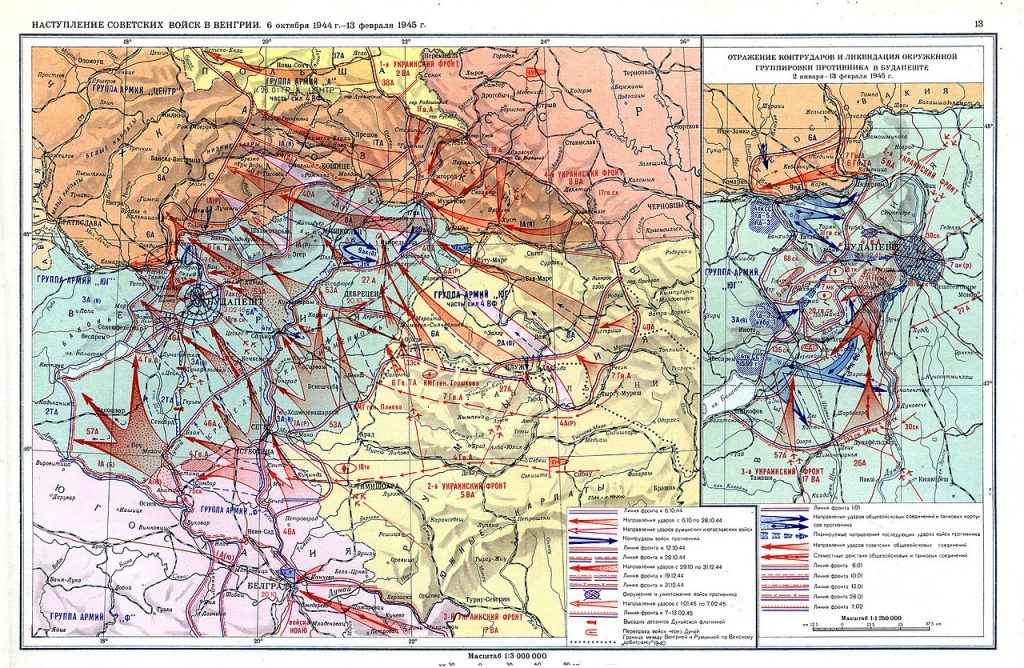
Budapest WW2 Operation Map
Battle of Budapest – Soviet Forces and Plan of Attack
2nd Ukrainian Front (consisting of 5 Soviet and 2 Romanian combined arms, 1 tank and 1 air armies – a total of 40 rifle divisions, 3 tank, 2 mechanized, 3 cavalry corps and 1 tank brigade) under the command of Marshal of the Soviet Union Rodion Yakovlevich Malinovsky at the beginning of the operation was located on the line Chop – Polgar – the eastern bank of the river. Tisza to Tisaug and further to Bai. The troops of the 3rd Ukrainian Front under the command of Marshal of the Soviet Union Fyodor Ivanovich Tolbukhin, having completed the Belgrade operation, by the beginning of the operation were just beginning to be transferred to Hungary (57th Army, reinforced by two mechanized corps). The task consisted in inflicting a frontal massive strike in the area of Budapest, withdrawing Hungary from the war, creating the prerequisites for an offensive in Austria and the Czech Republic.
The Soviet troops were opposed by the German Army Group “South” (Colonel General Hans Friesner ) consisting of 35 divisions (including 9 tank and motorized), and three brigades, as well as the remnants of the Hungarian army. At the disposal of the German command was a total of 190 thousand soldiers and officers, a heavily fortified large city and three defense lines, which rested their flanks on the Danube north and south of the city (part of the defense line “Margarita” (Hungarian “Margit”), which ran from the Drava River to the shores of Lake Balaton and Velence and the Danube bend near the town of Vácand further along the Czechoslovak-Hungarian border).
Battle Progress
The offensive on Budapest began with the forces of the 2nd Ukrainian Front on October 29, two days after the end of the Debrecen operation. The Soviet command decided to deliver the main blow with the forces of the 46th Army, the 2nd and 4th Guards Mechanized Corps southeast of Budapest and capture it. At the same time, the 7th Guards Army was to deliver an auxiliary strike from the area northeast of the city of Szolnok and capture a bridgehead on the western bank of the Tisza River. The rest of the front forces were given the task of advancing in the direction of Miskolc in order to pin down the opposing enemy troops and prevent their transfer to the Budapest area.The 3rd Ukrainian Front was supposed to complete the concentration of the main forces in the Banat area and at the same time to seize the bridgeheads on the right bank of the Danube on the territory of Hungary with advanced units.
The troops of the left wing of the 2nd Ukrainian Front broke through the enemy’s defenses and, after the 2nd and 4th Guards Mechanized Corps entered the battle, they began a rapid advance.
On November 2, the corps went from the south to the near approaches to Budapest, but could not break into the city on the move. The Germans transferred three tank and one motorized divisions here from the Miskolc area, which offered stubborn resistance. On November 4, the Soviet headquarters ordered the command of the 2nd Ukrainian Front to expand the offensive zone in order to defeat the enemy’s Budapest grouping with strikes from the north, east and south.
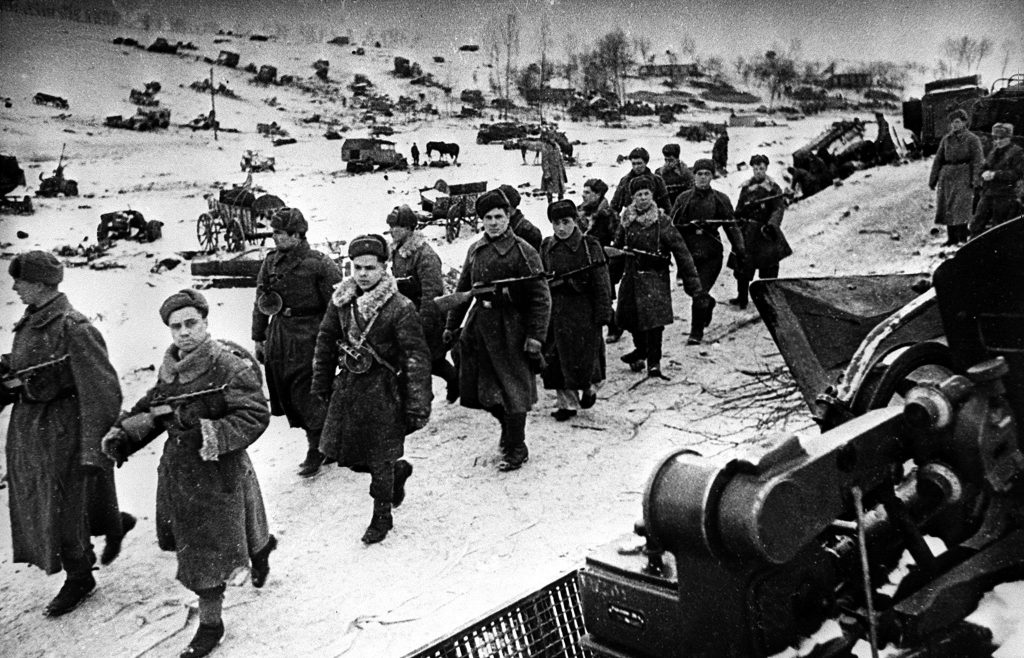
Budapest Operation Battle Wreckage
On November 11-26, the front’s troops broke through the enemy defenses between the Tisza and the Danube and, advancing up to 100 km in the northwestern direction, approached the outer defensive line of Budapest, but this time they were unable to capture the city. Faced with stubborn resistance, Soviet forces suspended attack.
In early December, an offensive was launched against Budapest by the forces of the center and the southern wing of the 2nd Ukrainian Front. As a result, Soviet troops reached the Danube north and north-west of Budapest, cutting off the retreat route to the north for the enemy’s Budapest group on December 5.
Troops of the 3rd Ukrainian Front (three Soviet and one Bulgarian combined arms and one air army – a total of 31 rifle divisions, 1 fortified area, a marine brigade, 1 cavalry, 1 tank and 2 mechanized corps ) by this time crossed the Danube with the active assistance of ships Danube military flotilla (see Gerjensky landing ), left northeast of Lake Balaton and created conditions for joint actions with the 2nd Ukrainian Front.
Having transferred reinforcements, the Germans launched strong counterattacks from December 7, which the troops of the 46th Army successfully repelled. 57th Army 3rd Ukrainian Front crossed the Danube on 7-9 November, at the Apatin-Kaposhvarskoy operations to December 9 came to the area south of Lake Balaton. From the second half of November on the right bank of the Danube, the 4th Guards Army, which arrived in the 3rd Ukrainian Front, began fighting, whose troops joined in the area of Lake Velence with the 46th Army. Thus, the enemy’s Budapest grouping was captured by Soviet troops from the north and southwest.
On December 10-20, the troops of both fronts were preparing for a new offensive. They were supposed to complete the encirclement, defeat the Budapest grouping and finally capture Budapest by joint attacks from the northeast, east and southwest. By the beginning of the offensive, the troops of the 2nd Ukrainian Front numbered 39 rifle divisions, 2 fortified areas, 2 cavalry, 2 tank, 2 mechanized corps and 13 Romanian divisions. Opposing the Soviet troops, the German Army Group “South” and part of the forces of Group “F” consisted of 51 German and Hungarian divisions and 2 brigades (including 13 tank and motorized divisions and 1 brigade).
On December 12, a directive was received to start the offensive on the 20th. Having launched an offensive, Soviet troops broke through the enemy’s defenses north and southwest of Budapest. On December 21, in the zone of operations of the 7th Guards Army in the area of Nemce, Sakalosha, Shagov, the German troops launched a counterattack, but came under blows to the flank and rear and were thrown back with heavy losses.
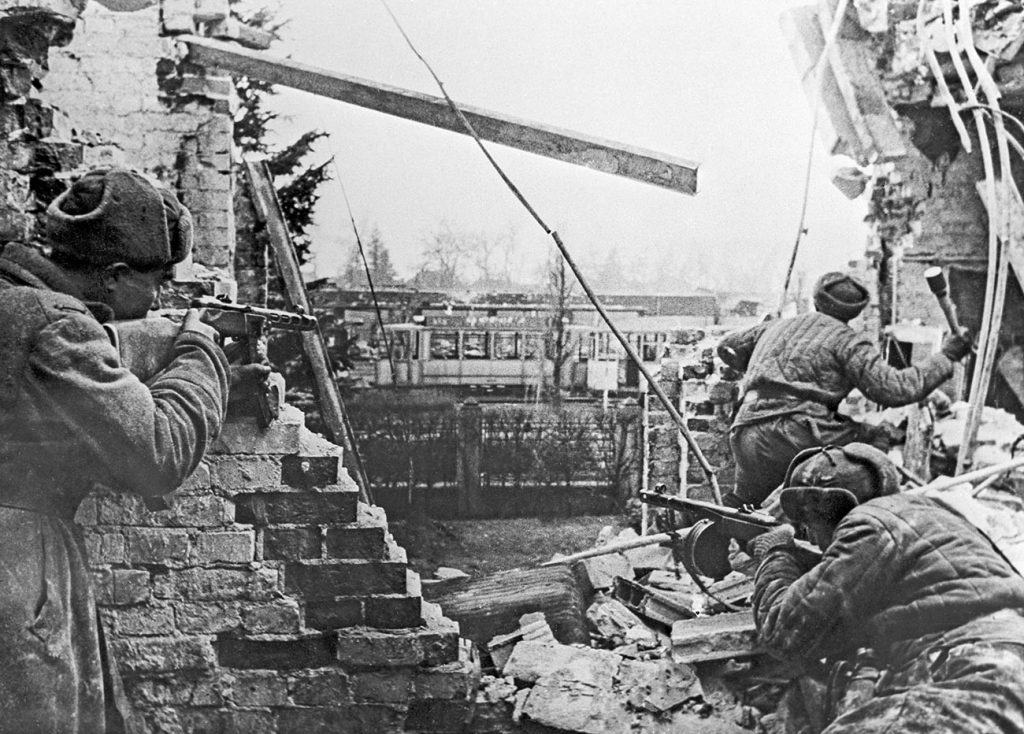
Budapest Operation Battle Throwing Grenades
On December 26, Soviet troops united west of Budapest in the area of the city of Esztergom, completely encircling the enemy’s Budapest grouping, 188 thousand people, including Hungarian units and SS units, got into the cauldron.
On December 29, the Soviet command sent an ultimatum to surrender to the encircled garrison. The letter with the ultimatum was to be delivered by the parliamentarians : Captain Ilya Ostapenko – to Buda, Captain Miklos Steinmetz – to Pest. When Steinmetz’s car with a white flag approached the enemy positions, German troops opened fire with machine guns. Steinmet and Junior Sergeant Filimonenko died on the spot. Ostapenko’s group was fired upon from mortars during the reverse crossing of the front line, Ostapenko died on the spot, two other members of the group survived.
On January 1, 1945, 13 tank, 2 motorized divisions and a motorized brigade were concentrated in Budapest. The Germans never had such a density of tank troops on the Eastern Front. Measures for the defense of the city were carried out under the leadership of the new commander of Army Group South – General Otto Wöhler, who was appointed to replace the removed Johannes Friesner. After that, fierce battles began to eliminate the garrison, which continued throughout January and the first half of February 1945.
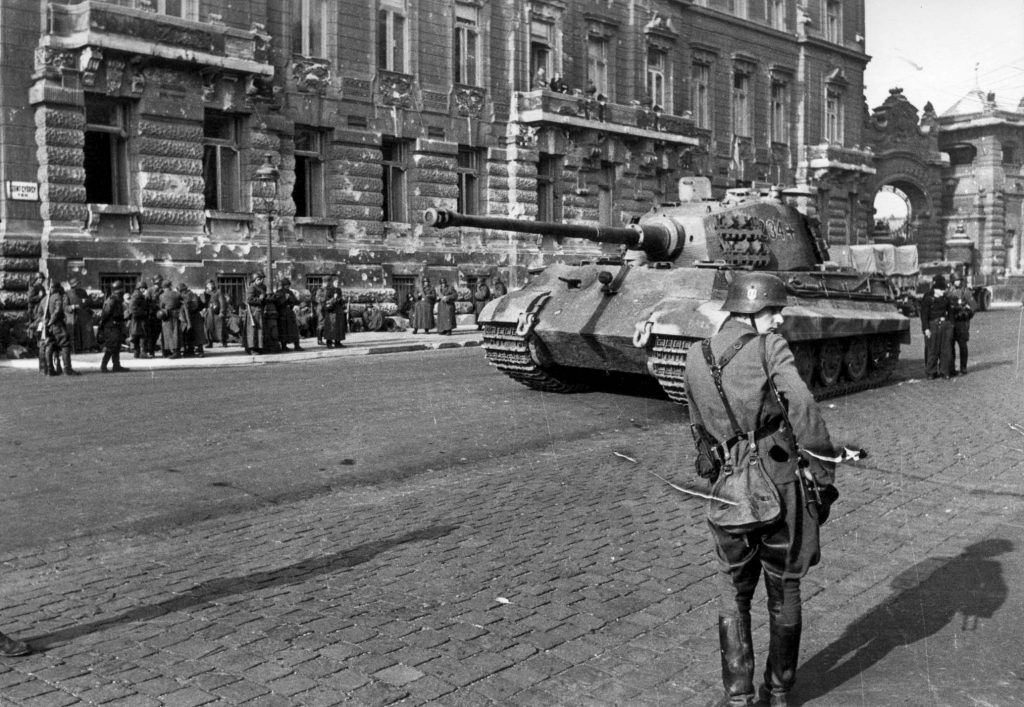
Budapest Operation Battle King Tiger
During the operation in January-February 1945, the troops of the 3rd Ukrainian Front, reinforced by units and formations of the 2nd Ukrainian Front, repulsed 3 strong counterattacks by German troops (Operation Konrad), who were trying to unblock the grouping surrounded in Budapest. When organizing counterattacks, German troops in some sectors created a density of up to 50-60 tanks per kilometer of the front. In this situation, the commander of the 3rd Ukrainian Front, Marshal Tolbukhin, used the experience of the Stalingrad and Kursk battles – in a short time his troops created an in- depth defense depths up to 25-50 km, which made it possible to stop the counteroffensive. An important role was played by the organization of effective reconnaissance, the timely opening of the advance and deployment of enemy groupings, which made it possible to deliver preemptive artillery and air strikes and to concentrate the main efforts in advance on threatening directions. Skillfully and timely maneuvering troops and anti-tank weapons, Soviet troops created in the most important sectors a density of up to 160-170 guns per kilometer of the front. So, on January 20, when the enemy, having escaped with tanks to the Danube in the Dunapentele region, at some point dismembered the troops of the 3rd Ukrainian Front, the self-propelled artillery regiments transferred to this sector by counter-strikes from the north and south eliminated the danger… In general, in January 1945, in the zone of the 3rd Ukrainian Front, the German-Hungarian troops managed to advance up to 30-40 kilometers and only in the zone of one of the armies did their maximum advance leave 60 kilometers, but the task of unblocking Budapest was not solved; by February 6, the offensive was completely exhausted in all directions.
In the first half of January 1945, the main forces of the 2nd Ukrainian Front launched an offensive on Komarno, which made it possible to somewhat reduce the counter-offensive impulse of the German troops.
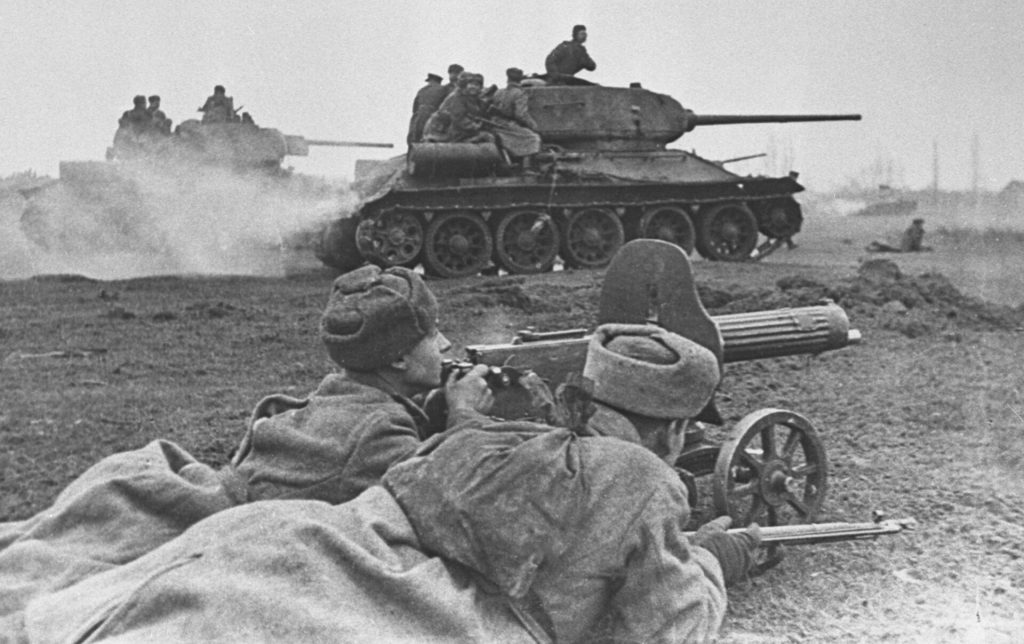
Budapest Operation Battle T-34-85
Simultaneously, from December 27, 1944 to February 13, 1945, the city battles for Budapest continued, which were led by a specially created Budapest group of forces (3 rifle corps, 9 artillery brigades from the 2nd Ukrainian Front (commander – Lieutenant General Ivan Afonin, then, in connection with the injury of Afonin, – Lieutenant General Ivan Managarov ) The German troops, numbering a total of 188 thousand people, were commanded by SS Obergruppenfuehrer Karl Pfeffer-Wildenbruch.
The battles were distinguished by special tenacity. By January 18, Soviet troops captured the eastern part of the city – Pest. The Soviet offensive in Buda began on January 20. The enemy put up stubborn resistance, but by February 11, his losses only by prisoners amounted to more than 26 thousand people. On the night of February 12, German and Hungarian troops made a last attempt to break out of the encircled city, concentrating significant forces in a narrow area. Over 12 thousand people broke through the front of the Soviet troops, but then almost the entire group that had broken through was destroyed by the troops of the 3rd Ukrainian Front. Only 785 people made their way to the German positions.
Only by February 13, the battle ended with the elimination of the enemy grouping and the liberation of Budapest. The commander of the defense, together with the headquarters, was taken prisoner.
In honor of the victory in Moscow, a salute was given with twenty-four artillery salvos from 324 guns.
Hungarian volunteers on the side of the Soviet troops
In the appeal of the Provisional National Assembly of Hungary, formed in Debrecen, occupied by the Soviet troops, to the Hungarian people on December 21, 1944, it was said: “You cannot indifferently watch how the Soviet army alone liberates our homeland from the German yoke. We will truly deserve the right to freedom, to independence only when we ourselves actively take part in our own liberation with all our might: we will embark on a sacred struggle against the German oppressors for the liberation of our homeland! ” The Provisional National Assembly specifically addressed the soldiers: “Honvedy! There is no other order for you than the order of the nation! The Provisional National Assembly on behalf of the Hungarian nation orders: turn your weapons against the German oppressors, help the Red Army – our liberator, join the liberation struggle of the people, join the new national armed forces that are being created! ” The Provisional National Government, created on December 22, headed by Colonel-General Bela Miklos-Dalnoki, pledged to form at least eight divisions.
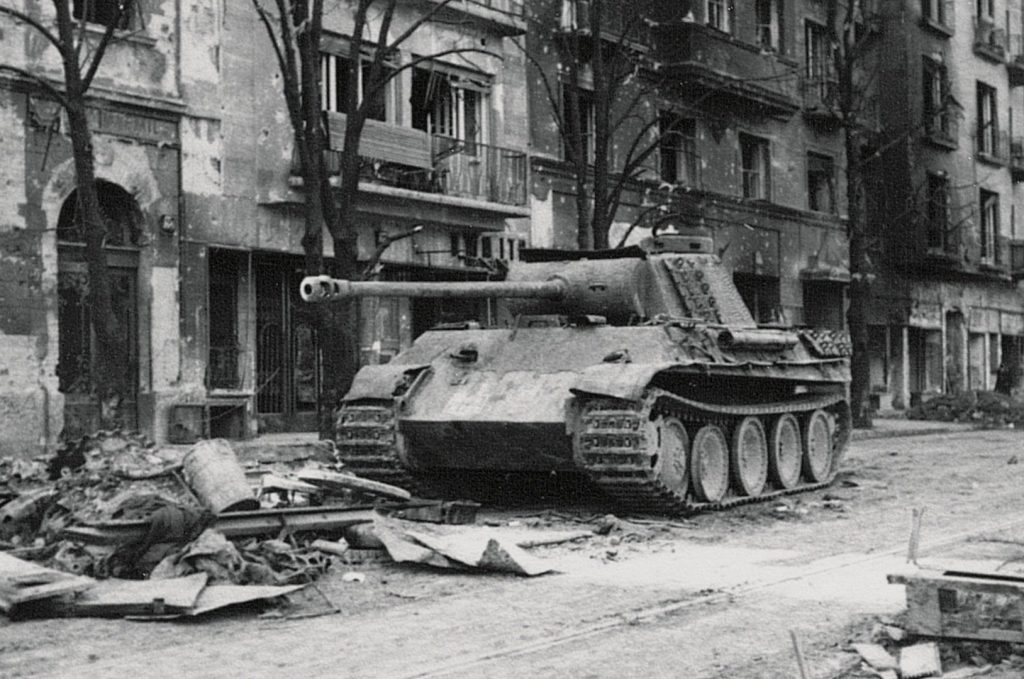
Budapest Operation Battle Panther Tank
On December 27, 1944, the Soviet command decided to create a railway construction detachment from Hungarian military personnel. Later, in mid-January 1945, on the basis of the detachment, the formation of the 1st railway construction brigade began, which was completed in February 1945. The brigade numbered 4,388 personnel, the brigade commander was Captain Gabor Dendes.
In the battles for Budapest, together with Soviet troops, 18 separate companies of Hungarian volunteers took part, most of which were subordinate to the 83rd Marine Rifle Brigade.
On February 11, 1945, 300 soldiers and officers of the 6th Infantry Regiment of the Hungarian Army went over to the side of the Soviet troops, including the regiment commander, Lieutenant Colonel Oskar Varikhazi and several staff officers. Later, from the Hungarian soldiers who went over to the side of the USSR during the battles for Hungary, the Buda Volunteer Regiment was formed, the commander of which was O. Varikhazi, his deputy – Arpat Pangrats. By the time the battles for Budapest ended, the regiment consisted of 2,543 servicemen. Subsequently, the regiment took part in hostilities against German troops in Hungary.
In general, in January – April, 1945 at the 2nd Ukrainian Front Hungarian railway brigade, and in early May 1945 in the composition of the two (1st and 3rd) were created and acted 3rd Ukrainian Front arrived two (1 1st and 6th) Hungarian divisions. The 1st and 6th Hungarian divisions did not have time to take part in hostilities at the front, but individual units of the 6th Hungarian division took part in disarming the remaining enemy groups in the Austrian Alps.
Results of the battle of Budapest
The troops of the 2nd and 3rd Ukrainian fronts liberated the central regions of Hungary and its capital, Budapest, the 188,000-strong enemy grouping was surrounded and destroyed, and Hungary was withdrawn from the war.
For 108 days, the troops of the 2nd and 3rd Ukrainian fronts defeated 56 enemy divisions and brigades. Forcing Hitler to transfer 37 divisions to Hungary from the central sector of the Eastern Front, the battle for Budapest facilitated the advance of Soviet troops in the western direction ( Vistula-Oder operation ).
The successful completion of the Budapest operation dramatically changed the entire strategic situation on the southern flank of the Soviet-German front and made it possible to develop deep coverage of the entire southern flank of German troops. A threat was created to the communications of the Balkan grouping of the enemy, which was forced to speed up the withdrawal of its troops from Yugoslavia. The troops of the 2nd and 3rd Ukrainian fronts were given the opportunity to develop actions in Czechoslovakia and in the Vienna direction.
On January 18, 1945, Soviet troops liberated about 70,000 Jews from the central Budapest ghetto. Two days earlier, Soviet soldiers had liberated another small ghetto, releasing thousands of Hungarian Jews. The Budapest ghetto became the only Jewish ghetto in Central Europe whose inhabitants were largely rescued.
Destruction in the city and casualties among the inhabitants of Budapest
As a result of the fighting, many buildings in the city were destroyed, and all five bridges over the Danube were destroyed. According to the historian Christian Ungvari, 38,000 Budapest citizens were killed during the siege, 13,000 of them were killed during the fighting and another 25,000 died from hunger and disease, as well as as a result of the murder of Jews by the Nazis (about 15,000 Budapest Jews were killed).
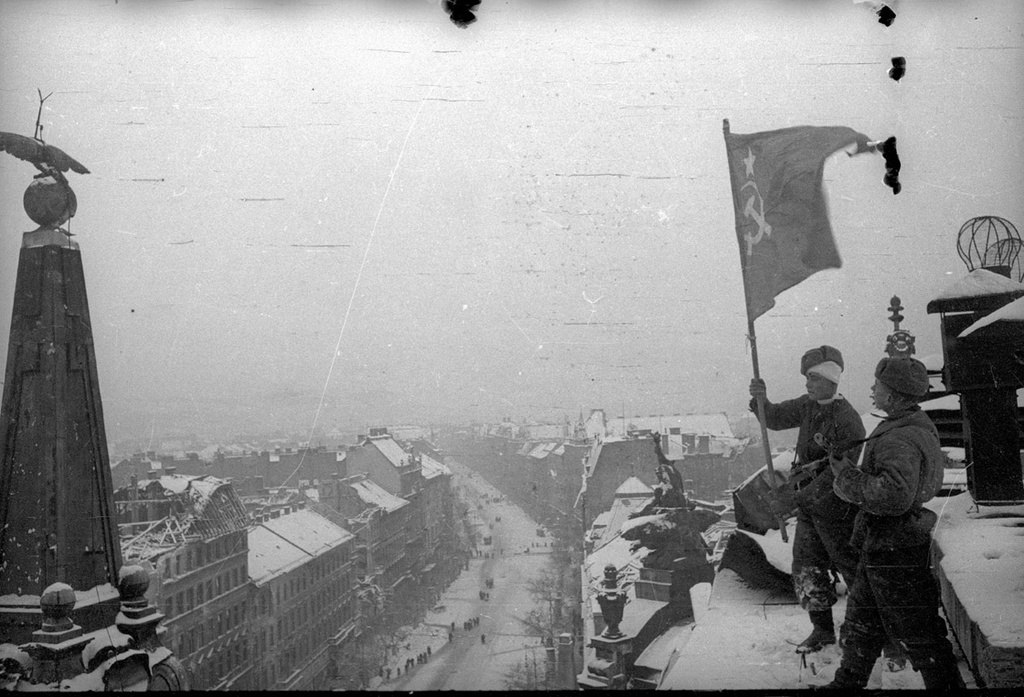
Budapest Operation Battle Red Flag
Heroes of the Soviet Union
- Ayanyan, Eduard Melikovich, the battery led by him destroyed 36 machine-gun and 20 sniper points, 40 houses with firing points, 12 vehicles with troops and cargo, two armored personnel carriers with a crew, the fire of four artillery batteries was suppressed, 41 soldiers and officers of the enemy were taken prisoner, captured 88 mm anti-aircraft gun. Despising death, under the incessant machine-gun and artillery-mortar fire, Senior Lieutenant Ayanyan went to the guns and personally supervised their movement to new places. In the most dangerous moments, he himself looked for the enemy’s firing points and often personally directed the guns at the target, destroying it with direct fire from a distance of 300-400 meters.
- Koryagin, Pyotr Kornilovich, foreman of the pontoon company of the 44th motorized pontoon-bridge battalion (2nd pontoon-bridge brigade, 46th army, 2nd Ukrainian front ) senior sergeant Pyotr Koryagin December 4, 1944 when crossing the Danube river 108- 1st rifle division in the area of the settlement of Sighetu Falu, located 20 kilometers south of Budapest, commanding the crew of the pontoon, landed an infantry assault on the pier of the city of Erdand, taking advantage of the confusion of the enemy, led the fighters into the attack. As a result of the bold and decisive actions of the brave warrior-pontoon, the Nazis were driven out of the trenches of the first position, and Soviet infantrymen under the command of senior sergeant PK Koryagin captured a bridgehead on the right bank of the Danube.
Received the Order of Glory III degree
- Ladanov Izosim Dmitrievich, Guards. sergeant commander of the crew 82 m / m-ba, 1 sat. 200 Guards cn. 68 GD of the 3rd Ukrainian Front during the offensive from 04/11/1944 on the outskirts of the city of Budapest and in the very center of the city comrade. Ladanov, in stubborn street battles, with his own crew destroyed the enemy machine-gun point and up to 35 enemy soldiers, thereby assisting the advancing units in taking possession of several quarters of the city.
- Shapoval (s) Fedor Dmitrievich, Jr. The sergeant was awarded the Order of the Red Star II degree, for the fact that in the battles during the crossing of the Tisza River on November 7, 1944, he rolled out his gun to direct fire close to the river, covering the crossing for rifle units, with well-aimed fire suppressed 2 enemy machine-gun points, which ensured the crossing of our units and foiled the enemy’s plans. Also on November 9, 1944, acting together with the infantry to expand the bridgehead, Shapoval’s gun with its well-aimed fire suppressed 3 enemy machine-gun and mortar points and repelled 2 enemy counterattacks.
- Volkov Nikolay Fedorovich, Guards. ml. sergeant. In battles with the German invaders on January 11, 1945, in the area of the village of Tovarosh (Hungary), Junior Sergeant Volkov, a reconnaissance battery of 76 mm cannons, repels the enemy attack and from his personal weapon destroyed up to 16 Germans and took two German soldiers prisoner, which ensured the separation of the retreating units from the pursuit of the enemy. Worthy of being awarded the Order of Glory, 3rd Degree. Commander of the 230th Guards Rifle Order of Kutuzov Regiment, Guard Lieutenant Colonel Baturkin. To award the Order of Glory of the 3rd degree. Commander of the 80th Guards Rifle Uman Order of Suvorov Division, Guards Colonel Chizhov.


